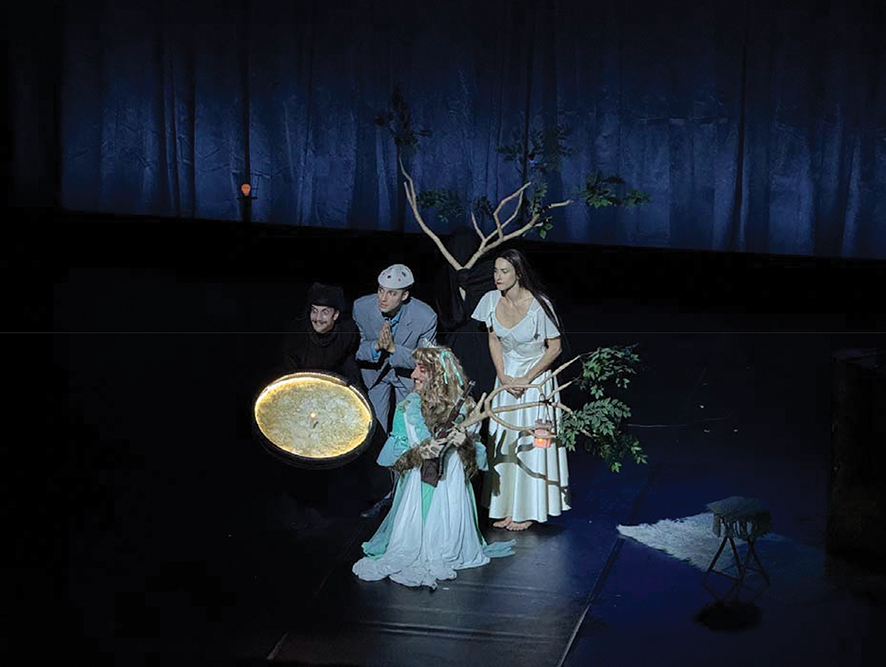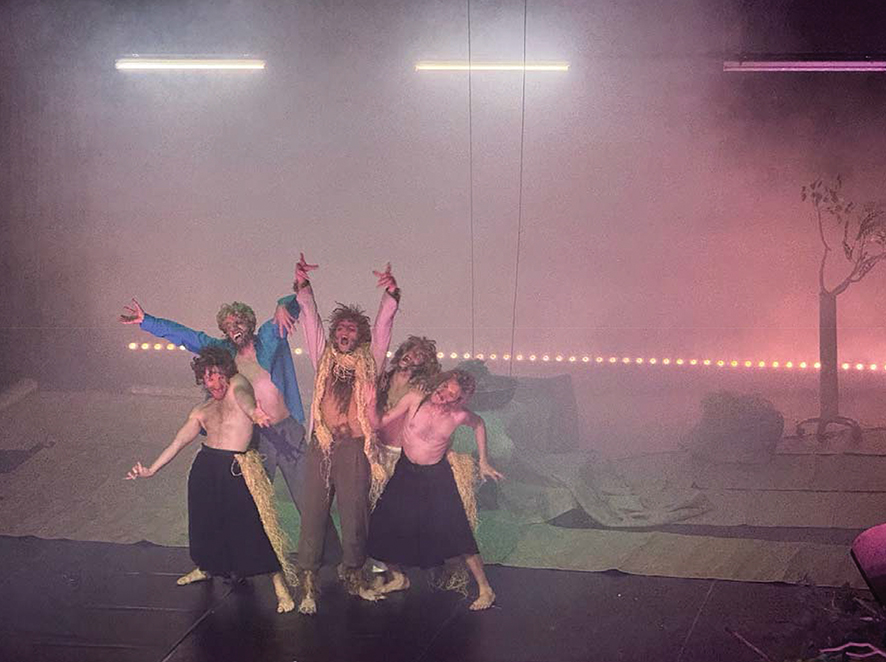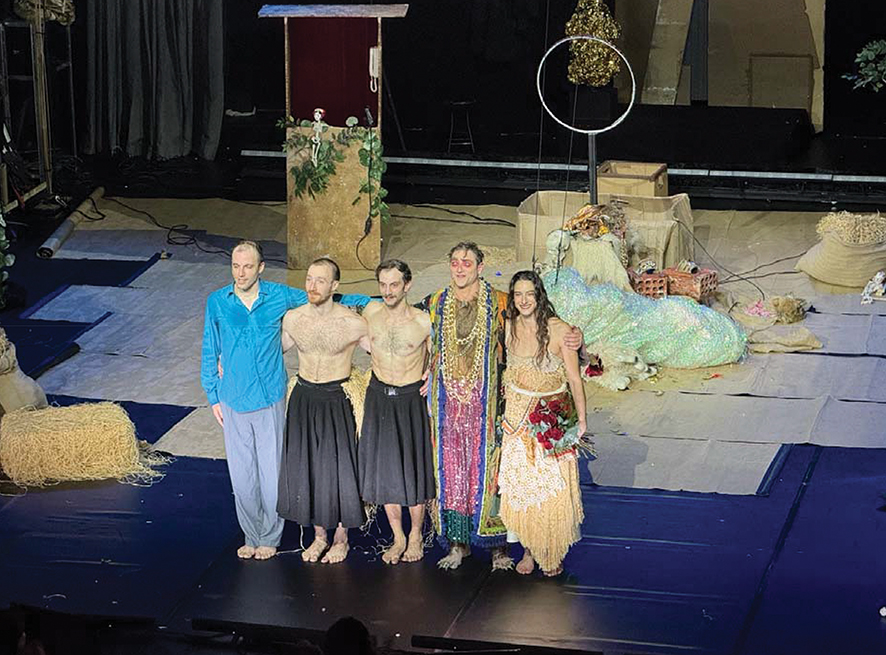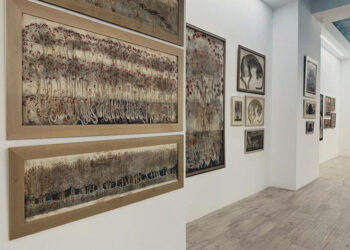At this year’s Georgian International Festival of Arts in Tbilisi (GIFT), Euripides Laskaridis’s Lapis Lazuli broke the boundaries of conventional theater, captivating audiences at the Marjanishvili Theater with a surreal, multi-sensory journey that unraveled the depths of human transformation. For 80 minutes, spectators were transported into a world where the mystique of a semi-precious stone became a metaphor for identity and resilience, underscored by the director’s singular, absurdist vision.
The “Stone from Heaven” as a Theater of the Absurd
In Lapis Lazuli, Laskaridis taps into the symbolic richness of the stone’s name, often called the “Stone from Heaven,” to explore contrasts between earthly resilience and celestial fragility. Much like the mineral, whose stunning blue color masks internal fractures, the performance suggests that under pressure, human identity is both enduring and unpredictable. This notion is rendered on stage in scenes that veer from the comic to the grotesque, transforming the theater into a space where contradictions and surprises unfold without the constraints of logic or linearity.
Blurring Realities: Werewolves, Seahorses, and the Power of Pataphysical Comedy
A standout scene features a werewolf figure clutching an oversized pink seahorse, creating an image that is as humorous as it is unnerving. This juxtaposition, what critic Anastazio Koukoutas dubs “neo-baroque,” is emblematic of Laskaridis’s style, which uses pataphysical comedy to blur the borders of reality. Here, comedy is not light-hearted, but rather subversive and disorienting, reminding audiences that humor is also a powerful tool for exploring the depths of human fear and vulnerability.
Through these absurdist images, Lapis Lazuli pushes beyond the boundaries of typical theater and into a space where the imagination reigns supreme. As reviewer Savvas Patsalidis notes, Laskaridis uses comedy to challenge “the dictatorship of seriousness” in contemporary theater, dismantling the idea that drama must convey life’s truths through solemnity. Instead, Laskaridis creates a dreamlike, ironic realm where laughter becomes an access point to existential contemplation.

A Cross-Cultural, Multi-Disciplinary Experience: The International Cast and Crew Behind the Dream
With an international co-production spanning countries like France, Greece, Italy, and Finland, Lapis Lazuli is a testament to the power of cross-cultural collaboration. From Giorgos Poulios’s original music to Stefanos Droussiotis’s intricate lighting design, each element builds a world that is both visually and sonically immersive. Droussiotis’s use of shadow and bold color mirrors the gem-like vibrancy of lapis lazuli, while Poulios’s soundscape amplifies the eeriness, combining electronic distortions and acoustic textures that reflect the surreal transformations occurring on stage.
Laskaridis’s choice of collaborators brings together varied theatrical and visual traditions, adding depth to a performance that, much like the stone, gleams with a spectrum of cultural influences. Set designer Sotiris Melanos, in collaboration with Christos Delidimos and Alegia Papageorgiou, crafted costumes that evoke other eras and artistic movements, creating an atmosphere where time itself seems fluid. This intricate layering of styles from Kabuki to Greek tragedy to classic Hollywood horror, as noted by the critics, reinforces the theme of fractured identities and the ambiguity of the self.

Beyond the Surface: A Performance of Transformation under Pressure
Much like the stone it takes its name from, Lapis Lazuli reflects the theme of transformation under pressure, which serves as a central metaphor in the performance. As audiences watch the performers mutate from one form to another, cloaked in intricate costumes or contorted into impossible postures, the performance draws attention to the constant flux of human identity. Laskaridis’s work reveals how pressure, both external and internal, molds individuals, pushing them to embrace or reject certain aspects of themselves in moments of crisis.
Laskaridis, described as a “visual artist, choreographer, dramaturg, and ingenious constructor,” approaches theater as a space for metamorphosis. In Lapis Lazuli, the stage becomes a pressure chamber where the performers’ bodies respond to unseen forces, contorting, collapsing, and re-emerging in altered states. This exploration of change reaches its height in the final scenes, which, like the stone itself, conceal a profound beauty beneath their fractured exterior.

The Timeless Appeal of Handmade Art and the Beauty of Imperfection
The handmade aesthetic of Lapis Lazuli is as much a statement as it is a stylistic choice. With each prop, costume, and set piece crafted meticulously by hand, the performance rejects the polish of digital precision in favor of an organic, tactile quality that draws viewers into the world Laskaridis has created. This “handmade, but far from simplistic art,” as noted by critic Eleni Koutsilaiou, is a celebration of the imperfect and the raw, qualities that lend Lapis Lazuli an authenticity that polished productions often lack.
The physicality of the performance, grounded in tangible materials and crafted objects, encourages audiences to experience theater as an intimate and direct encounter with art. The props and costumes, manipulated and transformed on stage, reflect the transitory nature of identity, emphasizing the idea that beauty often resides in moments of imperfection and transience.
The Grotesque and the Sublime: Reaching for the Heart over the Mind
Laskaridis has stated that Lapis Lazuli is designed to appeal “to our hearts, not our minds.” This approach aligns with Maro Vassiliadou’s observation that Lapis Lazuli is “entertainment for our hearts,” bypassing intellectualism in favor of pure sensory engagement. By deliberately rejecting clarity and linearity, the performance allows viewers to engage with the material on an emotional level, experiencing the strangeness of Laskaridis’s world as they would a dream—disjointed, confusing, yet ultimately resonant.
As each character wrestles with their own transformations, Laskaridis invites the audience to surrender to the performance’s rhythms and contrasts, to embrace the beauty and bewilderment that arise from letting go of intellectual analysis. Through this process, Lapis Lazuli fosters a space for open-ended contemplation, where meaning is found not in logical conclusions, but in sensory impressions.

The “Pataphysical” Mind of Euripides Laskaridis: Breaking Free of Conventional Theater
Lapis Lazuli exemplifies Laskaridis’s pataphysical approach to theater, a style rooted in paradox and absurdity that defies conventional analysis. In a time when much of contemporary theater leans toward abstraction and minimalism, Laskaridis’s work is a vibrant counterpoint. By embracing classic theatrical techniques and reinterpreting them through an avant-garde lens, he creates an experience that is both nostalgic and refreshingly new. This duality enables Lapis Lazuli to resonate with viewers on multiple levels, reminding us that theater can be both a reflection of society and a space to escape its boundaries.
As the performance closed, the audience at Marjanishvili Theater rose in applause—a testament to Lapis Lazuli’s ability to captivate, perplex, and ultimately transform. In an era where theater often seeks to impart meaning through seriousness and intellectual rigor, Laskaridis’s work stands out for its joyful embrace of the absurd. In Lapis Lazuli, we find a work that is at once beautiful, grotesque, and ultimately human; a piece that invites us to look within ourselves and discover the hidden, sometimes contradictory facets that make up our own inner worlds.
In the end, Lapis Lazuli does more than entertain; it changes us. Like the lapis lazuli stone, the performance exerts its own kind of pressure on its viewers, prompting us to reflect on our own transformations, our own capacity for change under the weight of life’s challenges. Euripides Laskaridis, through his whimsical, grotesque, and deeply human vision, offers not just a performance, but a mirror in which we glimpse both the beauty and fragility of the human experience.
By Ivan Nechaev














